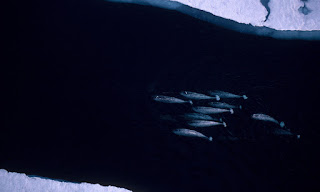The narwhal, or narwhale (Monodon monoceros), is a medium-sized toothed whale that possesses a large "tusk" from a protruding canine tooth. It lives year-round in the Arctic waters around Greenland, Canada, and Russia. It is one of two living species of whale in the Monodontidae family, along with the beluga whale. The narwhal males are distinguished by a long, straight, helical tusk, which is an elongated upper left canine. The narwhal was one of many species described by Carl Linnaeus in his publication Systema Naturae in 1758.
Like the beluga, narwhals are medium-sized whales. For both sexes, excluding the male's tusk, the total body size can range from 3.95 to 5.5 m (13.0 to 18.0 ft); the males are slightly larger than the females. The average weight of an adult narwhal is 800 to 1,600 kg (1,800 to 3,500 lb). At around 11 to 13 years old, the males become sexually mature; females become sexually mature at about 5 to 8 years old. Narwhals do not have a dorsal fin, and their neck vertebrae are jointed like those of other mammals, not fused as in dolphins and most whales.
Found primarily in Canadian Arctic and Greenlandic and Russian waters, the narwhal is a uniquely specialized Arctic predator. In winter, it feeds on benthic prey, mostly flatfish, under dense pack ice. During the summer, narwhals mostly eat Arctic cod and Greenland halibut, with other fish such as polar cod making up the remainder of their diet. Each year, they migrate from bays into the ocean as summer comes. In the winter, the male narwhals occasionally dive up to 1,500 m (4,900 ft) in depth, with dives lasting up to 25 minutes. Narwhals, like most toothed whales, communicate with "clicks", "whistles", and "knocks".
Narwhals can live up to 50 years. They are often killed by suffocation when the sea ice freezes over. Another cause of fatality, specifically among young whales, is starvation. The current population of the narwhal is about 75,000, so narwhals qualify for Near Threatened under the criterion of the International Union for Conservation of Nature (IUCN).
Explanation from: https://en.wikipedia.org/wiki/Narwhal














awesome
ReplyDeleteNature is wonderful.Living species of this kind exist in our Planet.
ReplyDelete